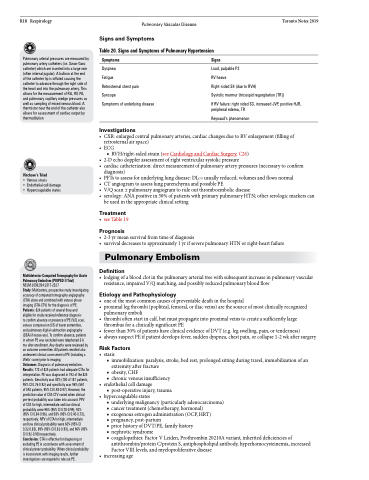Page 1264 - TNFlipTest
P. 1264
R18 Respirology
Pulmonary Vascular Disease
Toronto Notes 2019
Signs and Symptoms
Table 20. Signs and Symptoms of Pulmonary Hypertension
Pulmonary arterial pressures are measured by pulmonary artery catheters (i.e. Swan-Ganz catheter) which are inserted into a large vein (often internal jugular). A balloon at the end of the catheter tip is inflated causing the catheter to advance through the right side of the heart and into the pulmonary artery. This allows for the measurement of RA, RV, PA, and pulmonary capillary wedge pressures as well as sampling of mixed venous blood. A thermistor near the end of the catheter also allows for assessment of cardiac output by thermodilution
Virchow’s Triad
• Venous stasis
• Endothelial cell damage • Hypercoagulable states
Symptoms
Dyspnea
Fatigue
Retrosternal chest pain
Syncope
Symptoms of underlying disease
Investigations
Signs
Loud, palpable P2
RV heave
Right-sided S4 (due to RVH)
Systolic murmur (tricuspid regurgitation [TR])
If RV failure: right sided S3, increased JVP, positive HJR, peripheral edema, TR
Reynaud’s phenomenon
Multidetector Computed Tomography for Acute Pulmonary Embolism (PIOPED II Trial)
NEJM 2006;354:2317-2327
Study: Multicentre, prospective study investigating accuracy of computed tomography angiography (CTA) alone and combined with venous phase imaging (CTA-CTV) for the diagnosis of PE. Patients: 824 patients of several thousand
eligible for study received reference diagnosis
to confirm absence or presence of PE (V/Q scan, venous compression U/S of lower extremities,
and pulmonary digital-subtraction angiography (DSA) if necessary). To confirm absence, patients in whom PE was excluded were telephoned 3-6 mo after enrollment. Any deaths were reviewed by an outcome committee. All patients enrolled also underwent clinical assessment of PE (including a Wells’ score) prior to imaging.
Outcomes: Diagnosis of pulmonary embolism. Results: 773 of 824 patients had adequate CTAs for interpretation. PE was diagnosed in 192 of the 824 patients. Sensitivity was 83% (150 of 181 patients, 95% CI 0.76-0.92) and specificity was 96% (567
of 592 patients, 95% CI 0.93-0.97). However, the predictive value of CTA-CTV varied when clinical pre-test probability was taken into account. PPV
of CTA for high, intermediate and low clinical probability were 96% (95% CI 0.78-0.99), 92% (95% Cl 0.84-0.96), and 58% (95% CI 0.40-0.73), respectively. NPV of CTA for high, intermediate
and low clinical probability were 60% (95% CI 0.32-0.83), 89% (95% Cl 0.82-0.93), and 96% (95% CI 0.92-0.98) respectively.
Conclusion: CTA is effective for diagnosing or excluding PE in accordance with assessment of clinical pretest probability. When clinical probability is inconsistent with imaging results, further investigations are required to rule out PE.
• CXR:enlargedcentralpulmonaryarteries,cardiacchangesduetoRVenlargement(fillingof retrosternal air space)
• ECG
■ RVH/right-sided strain (see Cardiology and Cardiac Surgery, C26)
• 2-Dechodopplerassessmentofrightventricularsystolicpressure
• cardiaccatheterization:directmeasurementofpulmonaryarterypressures(necessarytoconfirm
diagnosis)
• PFTs to assess for underlying lung disease: DLCO usually reduced; volumes and flows normal
• CTangiogramtoassesslungparenchymaandpossiblePE
• V/Q scan ± pulmonary angiogram to rule out thromboembolic disease
• serology:ANApositivein30%ofpatientswithprimarypulmonaryHTN;otherserologicmarkerscan
be used in the appropriate clinical setting
Treatment
• seeTable19
Prognosis
• 2-3yrmeansurvivalfromtimeofdiagnosis
• survivaldecreasestoapproximately1yrifseverepulmonaryHTNorright-heartfailure
Pulmonary Embolism
Definition
• lodgingofabloodclotinthepulmonaryarterialtreewithsubsequentincreaseinpulmonaryvascular resistance, impaired V/Q matching, and possibly reduced pulmonary blood flow
Etiology and Pathophysiology
• oneofthemostcommoncausesofpreventabledeathinthehospital
• proximallegthrombi(popliteal,femoral,oriliacveins)arethesourceofmostclinicallyrecognized
pulmonary emboli
• thrombioftenstartincalf,butmustpropagateintoproximalveinstocreateasufficientlylarge
thrombus for a clinically significant PE
• fewerthan30%ofpatientshaveclinicalevidenceofDVT(e.g.legswelling,pain,ortenderness)
• alwayssuspectPEifpatientdevelopsfever,suddendyspnea,chestpain,orcollapse1-2wkaftersurgery
Risk Factors
• stasis
■ immobilization: paralysis, stroke, bed rest, prolonged sitting during travel, immobilization of an
extremity after fracture
■ obesity, CHF
■ chronic venous insufficiency
• endothelialcelldamage
■ post-operative injury, trauma
• hypercoagulablestates
■ underlying malignancy (particularly adenocarcinoma)
■ cancer treatment (chemotherapy, hormonal)
■ exogenous estrogen administration (OCP, HRT)
■ pregnancy, post-partum
■ prior history of DVT/PE, family history
■ nephrotic syndrome
■ coagulopathies: Factor V Leiden, Prothrombin 20210A variant, inherited deficiencies of
antithrombin/protein C/protein S, antiphospholipid antibody, hyperhomocysteinemia, increased
Factor VIII levels, and myeloproliferative disease • increasingage


